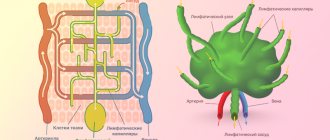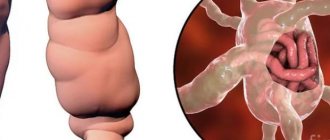Lymph is an “invisible” fluid. The average person knows almost nothing about it, it has been poorly studied by science, and the profession of a lymphologist is no less exotic than a harpsichord in a modern orchestra.
At the same time, lymph permeates our entire body. Just imagine: 2-4 liters in a person is lymph.
Why is it needed? To protect us from everything foreign and harmful that enters the body, and to provide immunity. It is believed that 80% of all diseases are caused by disturbances in the functioning of the lymphatic system.
Our beauty also depends on lymphatic drainage: the “angle of youth”, a clear oval of the face, toned cheeks, open eyes, smooth skin. Accordingly, problems with lymph entail swelling, bags under the eyes, drooping eyelids, extra chins, jowls, a blurred oval face, wrinkles and puffiness.
Take a closer look at this “invisibility” - you will be able to control your beauty, youth and health.
What is lymph
Most likely, you saw your lymph. Do you remember the clear liquid that comes out of a skinned knee? This is lymph. People also call it ichor.
Lymph is one of the three components of the body's fluid environment, along with blood and tissue fluid. And they are all interconnected, flow, transform into each other.
This is the fascinating cycle of fluids on which our lives rest.
The main task of lymph in this vast and ornate system of our internal “water channels” is to “pump out” everything foreign and harmful that ends up in our body.
Have you ever wondered how much “garbage” we collect inside of us? Some of it comes from the outside: with food and air we absorb toxins and harmful microorganisms (viruses, bacteria, fungi, parasites). Part is formed as a result of vital activity - the end products of metabolism. Our own cells also mutate and become malignant.
And this entire multi-billion dollar army is washed out of the body and cleansed by lymph.
Where does lymph come from?
Essentially, lymph is obtained from the blood.
First, the liquid part of the blood - plasma - enters the intercellular space through the thin walls of its capillaries and becomes the so-called tissue fluid. This term refers to a substance that is located between the cells of a living organism, washes them, filling the intercellular space.
There are about 10-11 liters of this tissue fluid in an adult. Not weak, right?
It is from this that lymph is formed. This occurs when intercellular fluid is absorbed into the lymphatic capillaries through their walls. The tissue fluid that has entered the lymph capillary is already lymph.
Now it will move along its own “transport network” (capillaries, vessels, trunks, ducts), stopping along the way in the lymph nodes to be cleansed of toxins and pathogens there. This entire structure is called the lymphatic system.
The final destination of the lymph is in the area of the collarbones. All the lymph collected throughout the body tends here to the large neck veins in order to get back into the bloodstream through them.
It is estimated that there is 1 liter of lymph per 20 kg of human weight. If you weigh 60-80 kg, then your lymph volume is 3-4 liters. At the same time, you have about 5 liters of blood.
If lymph formation is stimulated, the amount of lymph can reach up to 10 liters.
Compound
Lymph is connective tissue in the form of a liquid and is translated from Latin as “clear water.”
However, it is only 95-96% water. What else does it contain? First things first, white blood cells and proteins.
Leukocytes in lymph are mainly represented by lymphocytes. Lymphocytes are the main cells of the immune system, which ensure the production of antibodies and kill everything foreign and dangerous, be it toxins and pathogenic microorganisms that have penetrated from outside or their own mutant cells (cancer). A certain type of lymphocyte is even called killer cells. Lymphocytes mature in the lymphatic system, and the lymph is enriched with them in the nodes.
Proteins in lymph are albumins, globulins, fibrinogen, prothrombin. For them, lymph is an intermediate “distance”. All proteins that enter the intercellular space from the blood can only return to the bloodstream after passing through the lymph.
Also, at the initial stages of its journey, lymph is “contaminated” with various waste products, toxins, pathogenic microorganisms - everything from which it is cleared in the lymph nodes, and then flows clean into the circulatory system.
Lymph also contains lipids, hormones, enzymes, glucose, and minerals.
By the way, “clean water” doesn’t look exactly like water either. Lymph is viscous, and at certain stages of its journey it is translucent, with a yellowish tint.
Functions
Lymph is a faithful partner of blood. The functioning of each of our cells, which is “connected” to the liquid environment, depends on their strong union.
Blood transports gases, nutrients, and water to the cell. And the tissue fluid, washing the cell, takes away everything unnecessary and harmful from it (decomposition products, toxins, infectious agents) and carries all these “impurities” into the lymphatic system as lymph.
Roughly speaking, lymph sucks all the “dirt” from the cells and sends it through its channels for cleaning. Drainage of various tissues and organs is the main function of lymph (cleaning).
But that's not all. Lymph provides communication between blood, tissue fluid and lymphoid organs (red bone marrow, thymus, lymph nodes, tonsils, spleen) in several directions. What exactly does she do?
- removes toxins, metabolic products, pathogens from tissues and organs and delivers them to their nodes to destroy,
- transports lymphocytes and antibodies from lymph nodes to the circulatory system,
- returns water, proteins, minerals, electrolytes that the body needs to the blood,
- ensures the maintenance of a constant composition and volume of tissue fluid,
- absorbs and transports breakdown products of nutrients (primarily fats) from the intestines into the venous system,
- leaves enzymes in the blood, and for some of them (histaminases, lipases) lymph is the only “carrier”.
What are the differences between blood and lymph?
When scientific minds turned their attention to lymph several centuries ago, they called it “white blood,” and it’s clear why. Blood and lymph are liquids that are always nearby, working in tandem, the lymphatic system runs parallel to the circulatory system. Lymph is obtained from the blood and as a result enters the blood again.
But still these are different liquids. Take their composition, for example.
Unlike blood, in lymph:
- more water and lymphocytes (this type of leukocytes is considered lymph cells, and there are more other leukocytes in the blood),
- no red blood cells or platelets,
- less proteins (3-4 times), which makes the lymph less viscous and dense.
Lymph and blood differ in many other ways. Main:
- Blood delivers everything useful (oxygen, nutrients) to the cells, lymph takes everything harmful from them (pathogens, end products of metabolism, toxins) and then utilizes all this “garbage”.
- Lymph moves slower than blood and clots less well.
- The circulatory system is closed (blood moves in a circle), and it has its own pump organ in the form of a heart. The lymphatic system is not closed, lymph flows in one direction (from bottom to top) and does not have a special pumping organ.
Lymph movement
The entire path that lymph travels from its capillaries to its final destination in the form of the neck veins is lymphatic drainage.
Lymph flows slowly, and its main engine is muscles. They contract and push fluid through its channels. The most important “pump” is the diaphragm, which is even figuratively called the “heart” of the lymph. We breathe - the lymph is already moving. If we add physical activity, we use different muscles - it flows faster.
A clear example of the fact that breathing alone is not enough for full lymph flow is our morning swelling. The muscles spend the night in a relaxed state, and by morning the tissue fluid and lymph stagnate. I did some exercises and the swelling began to recede.
The lymph route is from bottom to top and from the periphery to the center. It starts from the tips of the fingers and toes. Then it goes higher, collecting along the way everything that has been absorbed through the lymphocapillaries from other tissues and organs. And eventually it gets through its channels to the large veins of the neck. This is where it returns back into the bloodstream.
The exception is the face and neck. Here the route is different: lymph flows from top to bottom, towards the same venous bed.
Lymph movement pattern
It is estimated that every day a person inhales several grams of insoluble fine dust particles. In a year you gain almost one and a half kilograms, and in a lifetime - about 70 kg. Where does such a colossal amount of garbage go? If it were not for the lymphatic system, not for the protective organs and tissues, not for the constant intra- and extracellular confrontation, then all the aggression that is present in our lives every day would not allow a person to exist in principle. Anatoly Georgievich Konevsky, a legendary professor from the Department of Topographic Anatomy and Operative Surgery of Volgograd State Medical University, told how important it is for any doctor, and especially a surgeon, to pay attention to the lymphatics.
Many diseases are treated as if the lymphatic system does not exist. This is nonsense, because it performs a huge number of vital functions for the body. Back in the middle of the 20th century, the famous French scientist Henri Policard Fr. And this thesis is still relevant today. Moreover, the lymphatic system should be almost the most studied system in the body. Why? Anatoly Georgievich Konevsky, an outstanding professor and famous surgeon who gave a considerable impetus to the development of transplantology in Russia, acted as the living Henri Policard and revealed the secrets of lymph circulation to the students.
“You walk along the sidewalk in the morning, cars pass by you, you inhale the dust of the streets, clouds of exhaust gases, you go into a trolleybus, and if suddenly there is at least one patient with an open form of tuberculosis, then you get your package of Koch sticks, and if someone else If you sneeze, you will get a tangle of a wide variety of both non-pathogenic and pathogenic microbes. But you live on. Where does all this go?” - the professor began his story.
When was the mysterious system discovered?
In 1613, the medieval Italian anatomist Gaspare Aselli, while teaching an anatomy class, dissected a dog to show students the internal organs. However, before this the animal was fed. Naturally, the first thing the scientist and his students saw were intestinal loops entangled in many small white vessels with glomeruli, from which, when cut, a white liquid similar to milk oozed. This was not the first experience of meeting the “milky ways” - 50 years before this incident, Bartolomeo Eustachius, also an Italian, isolated the thoracic lymphatic duct on the corpse of a horse, without understanding the significance of the discovered anatomical formation and calling it the “white thoracic vein.” Lymphatic vessels were equated with veins until the advent of the microscope, and in the second half of the 18th century, the German anatomist Johann Lieberkühn finally found out that there are separately existing lymphatic capillaries that originate in the intestinal villi and carry their secretions into the venous bed.
Actually, the comparison of the vessels of the venous and lymphatic systems was not carried out by chance - along with closely related development, they have many common features, such as the movement of fluid from tissues to the heart and the presence of a valve apparatus, as well as some differences (the presence of nodes and the blind end in carriers lymph).
“You all know that half the weight of the human body is liquid,” the professor continued to broadcast. – “Basically, it is cellular and extracellular fluid, and there are 28 liters of it! Just imagine: you walk, run, and there are three buckets of water in you, which does not splash or gurgle...” The fluid of our body is in constant motion. And through the liver, as the main organ of the protective and permeable system, about one hundred liters of blood and lymph pass through in 24 hours.
How does the lymphatic system work?
The lymphatic scientist Bartels in 1909 identified three main types of lymphatic “substances”: lymphatic vessels of various calibers from capillaries to crevices, lymphatic organs and the so-called lymphatic collectors - the cavities of the pericardium, pleura, peritoneum, nervous system (ventricles of the brain and not only) . And all these “substances” are in constant interaction with each other.
The lymphatic capillary is a hollow tube, closed on one side, with a radius of three microns. As a result of plasma filtration in the blood capillaries, the fluid enters the intercellular space and becomes tissue, part of it is reabsorbed back into the blood, and part of it enters the lymphatic capillaries, forming lymph. Thus, lymph is the space of the internal environment of the body, consisting of interstitial (intertissue) fluid.
An interesting fact is that there are about 44 billion vessels of the lymphatic system in the body. Their length is twice as long as the length of the vessels of the circulatory system, and is about 200,000 km. Such a large extent, but almost zero pressure. How then does movement happen, you ask? Simple: pressure forces - oncotic (due to the proteins contained in the lymph) and hydrostatic (due to the gradually expanding diameter of the vessels), as well as due to respiratory movements and the work of the diaphragm. Gradually concentrating, the vessels eventually form the right lymphatic duct and the thoracic duct, which flow into the right and left subclavian veins, respectively, and from there into the superior vena cava.
“When the lymphatic duct is blocked, a person becomes an urn! It turns into a toilet where all sorts of impurities are drained without finding a way out. Therefore, cutting large lymphatic trunks is not compatible with life,” the professor notes.
What are lymph nodes needed for?
Lymph nodes are a storehouse of lymph and the cradle of the immune system and immunocompetent cells. The node itself produces lymphocytes, and here (mainly) the fight against microorganisms carrying foreign genetic information occurs.
“What do microbes think about when they find themselves in a favorable environment? We need to multiply!”
However, tumor cells also enter the lymph nodes and can circulate with the lymph flow. They settle there and also begin to multiply. The knot enlarges and becomes dense, like a stone, often immobile. This is especially noticeable when palpating the supraclavicular groups, groups located along the posterior edge of the sternocleidomastoid muscle and others. Such changes, indicating the beginning of the process of metastasis, can become the only manifestations of formidable and often fatal tumor processes in various organs. To confirm his words, the professor said
Case Study: Smoking Really Kills
When Anatoly Georgievich worked as a surgeon in Kalmykia in the summer together with student interns, a patient came to him - a young, beautiful, blooming girl. She complained of what she called a small swelling above her collarbone. At the district clinic she was told that this swelling could be easily removed, and that the city hospital had a very good surgeon. So she arrived. The future professor, after examining the patient, left the examination room gloomy and gloomy. The students, intrigued by his appearance (the girl was beautiful, and also unmarried), surrounded him and began asking him what was the matter. To which Anatoly Georgievich replied: “I witnessed a real human tragedy... In a month, this young and blooming girl will die, because she has cancer of the left lung in an inoperable stage.” And he noted that the reason for such a sad outcome was smoking - the girl had been smoking almost a pack of cigarettes a day since school.
By the way, Michael DeBakey, a famous American heart surgeon, was one of the first to suggest a cause-and-effect relationship between smoking and lung cancer. In 1951, British scientists proved this connection with the British Doctors Study. So think about it, those who like to smoke in the name of relaxing their nerves...
Various complications with damage to the lymphatic system are also by no means harmless. For example, chylothorax, or a lymph-filled pleural cavity, can be fatal. Or another extremely unpleasant pathology - lymphostasis, the advanced form of which everyone has probably heard of as “elephantiasis” or “elephantiasis”. This is a fairly common postoperative complication precisely because, when restoring the integrity of tissues, surgeons rarely pay due attention to restoring the integrity of the lymphatic vessels. And we must not forget about this!
Instead of a total
“You entered medical university. No one but yourself will make you a knowledgeable and skilled doctor when you receive your diploma. Only you! A month has passed - look back, see what you have acquired during this time for your future profession? Studying at the university is the most difficult period in your life and it then decides your fate. Take it seriously."
Anna Horuzhaya
Human lymphatic system
So, the lymphatic system (like the circulatory system) has its own extensive “transport network”. Almost every cell of ours is “connected” to it, or rather, the intercellular space.
The route of lymph along it is: “capillaries – vessels – nodes – vessels – trunks and ducts.” Let's go through it in more detail.
Lymphatic capillaries
Capillaries are the initial link of the lymphatic system. It is through their thin walls that tissue fluid is absorbed from the intercellular space and, once inside the capillary, becomes lymph.
Capillaries consist of large cells, between which there are gaps - tissue fluid leaks into them. Dissolved substances, some microorganisms and cells penetrate with it.
The thinnest tubes of capillaries are inextricably linked with each other and have a so-called closed (“blind”) beginning, therefore the movement of lymph is unidirectional: from the periphery to the center.
Lymphocapillaries permeate almost the entire body, with rare exceptions. They are not found in the central nervous system, superficial layers of the skin, red bone tissue of the brain, cartilage, brain, mucous membranes, eyes, oral cavity, inner part of the ear canal, placenta.
Lymphatic vessels
Vessels are the next stage of lymph movement. They are formed when capillaries merge with each other. Vessels have a larger diameter and thicker walls.
The middle layer of blood vessels is smooth muscle tissue, which ensures the movement of lymph.
The vessels have valves, thanks to which lymph can only move in one direction. They are located approximately every half centimeter.
From small vessels, lymph flows into larger ones, which ultimately enter the lymph nodes. And at the exit from the nodes, the vessels become even more enlarged, forming so-called collectors.
Usually 2-4 afferent vessels go to the node, and 1-2 efferent vessels depart.
Lymphatic vessels are found almost throughout the body. They are located parallel to all large veins and vessels of the circulatory system.
The lymph nodes
Lymph nodes are the place where lymph is filtered from all the “dirt” that it has collected throughout the body: toxins, pathogenic microorganisms, metabolic products, malignant cells. If the lymphatic system is a sewer, then the lymph nodes are septic tanks. It is in them that lymphocytes do their work (recognize and kill harmful agents) and produce antibodies.
Typically nodes are arranged in “flocks”. They are found in all parts of the body (except the back) and near important internal organs. Where exactly? Near the ears, under the jaw, in the area of the collarbones, under the armpits, in the mammary glands, in the groin, under the knees, near the internal organs, etc.
Lymph from nearby tissues and organs rushes to each group of nodes. It is sequentially purified in several nodes, one after another, and in them it is enriched with lymphocytes and antibodies. Having passed through all such “settlements”, it is already moving towards the bloodstream - clean and filled with immune cells.
Lymphatic trunks and ducts
After the nodes, lymph flows through the vessels into the trunks and ducts. These are the main lymph pathways. They are formed by connecting blood vessels.
There are a total of 6 trunks and ducts in our body. They have valves, thanks to which lymph moves only from bottom to top.
The fluid is transported through the trunks and ducts into the venous bed in the clavicle area - the gateway for the lymph flow to enter the bloodstream.
Types of lymph
The so-called peripheral lymph that has not passed through the lymph nodes is isolated; central, contained in the thoracic duct, and intermediate (transient), passing through 1-2 lymph nodes. Their cellular and chemical compositions are not the same: the central lymph contains more protein and cellular elements, the composition of the peripheral lymph changes depending on the characteristics of the activity and metabolism of the organ (body part) from which it flows. Thus, lymph flowing from the intestines contains a significant amount of enzymes, gastrointestinal hormones, fats, fat-soluble substances, and vitamins. Lymph flowing from the endocrine glands is characterized by a higher content of hormones produced by these glands.
Diseases of the lymphatic system
As long as the lymph flows freely along its paths, and nothing prevents the nodes from doing their job, the body is protected from everything foreign and dangerous.
But imagine a few situations:
- Too many toxins and pathogens have entered the body, and the lymphatic system cannot handle such a load; the nodes cannot cope with all the “dirt.”
- Lymphatic vessels are damaged, narrowed, spasmed, or become compressed under the influence of external factors - the outflow of lymph is disrupted.
- The vascular system is naturally underdeveloped, there are not enough vessels and capillaries, or the vessels have some kind of congenital defect (lumen defect, cyst, etc.).
There are many reasons why the lymphatic system can fail. As a result, the lymph nodes will become clogged and inflamed, or the vessels will become obstructed, or a tumor of the lymphatic tissue will develop, etc.
What are the consequences of diseases of the lymphatic system? Decreased protective function of the body. Where will the entire army of pathogens that the lymph cannot cope with end up? Into the blood, and through it they will poison the body, cause inflammation, and provoke organ dysfunction.
For example, the inguinal lymph nodes are responsible for reproductive function and protect the reproductive organs from aggressors that come from the lower part of the body. Their inflammation can lead to difficulty conceiving.
The main diseases of the lymphatic system are:
- pathologies of the lymph nodes: lymphadenopathy (enlargement) and lymphadenitis (inflammation),
- tumors of lymphatic tissue: lymphogranulomatosis (malignant) and lymphosarcoma (benign),
- lymphostasis (stagnation of lymph due to impaired outflow).
What do you need to know about these diseases?
Lymphadenitis and lymphadenopathy
Lymphadenopathy is an enlargement of the lymph node, lymphadenitis is its inflammation (accompanied by enlargement).
Lymphadenopathy is not a disease, but a symptom, a signal that there are some abnormalities in the body.
Lymphadenitis is already a dangerous disease. The inflamed node greatly enlarges, it hurts, the skin around it turns red, and it is unable to perform its functions.
Most often, enlargement and inflammation of nodes are secondary processes, a reaction to some other infection and inflammation, with a different location.
How is everything going? An infection from some source (sore throat, wound on a finger, inflammation of the reproductive organs, etc.) enters the node along with the lymph. The node actively fights against malicious agents and grows with zeal. But if the attack is too powerful and it is not possible to cope with it, the node will eventually become inflamed.
Usually the source should be looked for somewhere nearby.
- If the infection has affected the upper respiratory tract, then the nodes in the neck, near the ears, and under the jaw may become inflamed.
- If it is a festering wound on the arm or a disease of the mammary glands, the axillary nodes suffer.
- A leg fracture in the foot or leg area or some kind of local infection? The popliteal nodes become inflamed.
- Sexual infection is the cause of enlarged lymph nodes in the groin.
The presence of infection nearby increases the load on the lymph node. He is forced to work hard. And lymphocytes, despite their rapid proliferation, may not be enough to neutralize pathogens. Then the node becomes inflamed.
This is the most common scenario, although there are others.
But in any case, the size of the lymph nodes should be treated carefully. An enlarged node is a “red button”, which gives a signal that something is wrong in the body. It could be a simple cold, or it could be a serious illness.
Lymphomas
Lymphoma is a disease of the lymphatic tissue. It can manifest itself as a malignant tumor (lymphogranulomatosis) or benign (lymphosarcoma). In both cases, the first sign of pathology is enlarged lymph nodes.
Lymphogranulomatosis is difficult to identify in the initial stages due to the lack of specific symptoms. The disease progresses rapidly, is difficult to treat (chemotherapy, bone marrow transplantation) and often ends in death.
A benign tumor should also be taken as seriously as possible, as it has the risk of becoming malignant.
Lymphostasis
Lymphostasis is a pathological stagnation of tissue fluid. It occurs due to impaired lymphatic drainage and is accompanied by an increase in the affected organ or part of the body. Develops as a result of a congenital anomaly (insufficient blood vessels, or their diameter is reduced or increased) or damage to the lymphatic system during life (trauma, surgery).
Lymphostasis of the arms or legs is most common. If the disease progresses, it leads to elephantiasis (a multiple increase in the volume of the limb). In extreme forms, an arm or leg may become immobilized, and the person will become disabled, without the ability to self-care.
What tests and diagnostics need to be done for lymph?
It is important to monitor the health of the lymphatic system.
You yourself are able to at least regularly check the size of your lymph nodes - on the neck, under the lower jaw, under the arms, in the groin. If the increase does not go away for a long time or inflammation develops, you need to consult a specialist.
What do doctors have in their arsenal?
The composition of the lymph is determined by biopsy of the node - puncture and collection of its contents for analysis. This is a serious and traumatic procedure. It is carried out in extreme cases: when there is a suspicion of cancer, the nodes are enlarged and inflamed for a long time.
Basically, the functioning of the lymphatic system is assessed by blood tests - first of all, changes in the number of lymphocytes are monitored. Lymphoma can be diagnosed using a biochemical blood test.
To identify inflammation of the lymph nodes and determine the cause of lymphostasis, hardware techniques are also used: ultrasound, X-ray, MRI, CT.
Lymph cells
Formed (cellular) elements of lymph, or lymph cells, are represented mainly by lymphocytes (90-98%), as well as monocytes and other types of leukocytes. The ratio of the volume of formed elements of lymph to its total volume (lymphocrit) is less than 1%. Since lymph contains fibrinogen, prothrombin and platelets, it is capable of clotting, although more slowly than blood.
The volume of circulating lymph is difficult to determine, however, experimental studies show that on average 1.5-2 liters of lymph circulate in a person.







